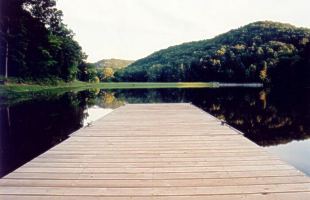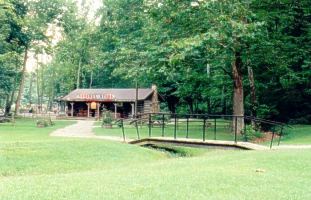| Hocking Hills State Parks -
Tar Hollow |
click photo to see larger picture |
Tar Hollow
Twisting park and forest roads pass through deep ravines and dense woodlands. Scattered
short leaf and pitch pines growing on the ridges were once a source of pine tar for early
settlers, hence the name Tar Hollow. Dogwoods, redbuds and a variety of wildflowers color
the hillsides in the springtime. Fall's pageant of color is spectacular.
Nature of the Area
At one time, Ohio was covered by a warm, shallow sea. As land rose to the east, sand and
gravel were washed westward into Ohio's waters. Southeastern Ohio's sandstone was formed
from this sediment. These sandstone hills are covered with a rich, diverse forest. Oak and
hickory prefer the dry ridge tops of the area, while
 sycamore, black willow, buckeye and
silver maple line the stream valleys. The forest not only supports a variety of hardwoods
but also contains a vast array of ferns, mosses, mushrooms and wildflowers. Bloodroot, wild
geranium, cardinal flower and Solomon's seal are typical wildflowers found in the forest.
sycamore, black willow, buckeye and
silver maple line the stream valleys. The forest not only supports a variety of hardwoods
but also contains a vast array of ferns, mosses, mushrooms and wildflowers. Bloodroot, wild
geranium, cardinal flower and Solomon's seal are typical wildflowers found in the forest.
Surrounded by the rugged foothills of the Appalachian Plateau, Tar Hollow State Park and
surrounding state forest are characteristic of the wilderness that blanketed Ohio in the
days of early settlers. It is a stronghold for many exciting species of wildlife. Numerous
reptiles and amphibians, colorful game birds, songbirds and secretive mammals can be found
here. The timber rattlesnake, dwindling in Ohio due to deforestation, hold son in Tar
Hollow's forest. The five-lined skink, distinguished by its brilliant blue tail, is found
in the area along with the elusive fence lizard. Painted turtles can be seen along
the shores of Pine Lake while the lumbering box turtle inhabits the dry land. Salamanders
such as the red-backed, dusky, long-tailed and northern two-lined thrive on the cool, moist
forest floor. In spring, the wooded hollows echo with the gobbling of wild turkey and the
drumming of the ruffed grouse. Rare sightings of bobcat have been reported in this unique,
wild region.
History of the Area
This region was wilderness to early man. Indians and settlers both found the land,
especially in the valleys, to be rich and fertile. Many different Indian tribes contributed
to its history. From about 200 B.C. to 500 A.D., the Hopewell inhabited the area. This
culture left burial mounds that can still be seen. Later both the Shawnee and Mingo claimed
the area as hunting grounds.
In 1796, Nathaniel Massie platted a town on the Scioto River just north of the mouth of
Paint Creek which he named Chillicothe. One hundred of the first lots were offered free
to the first settlers. Farm lots in the area were sold for one or two dollars an acre, in
100- to 200-acre tracts. The area attracted many Kentuckians and Virginians. In 1803,
Chillicothe became the state capital.
For a time, the ridges to the east of Chillicothe remained wilderness because the hills
were too steep to farm. But as the pressure for land and lumber increased, the hills of
 Tar
Hollow were gradually cleared and inhabited by marginal farms. Life was difficult and
settlers took advantage of every resource available. The region derives its name from pine
tar, an essential commodity in early Ohio households. It was taken from the knots and
heartwood of the native Pitch Pine tree to be use din the home manufacture of balms, animal
liniments, and lubricants for pioneer wagons and equipment.
Tar
Hollow were gradually cleared and inhabited by marginal farms. Life was difficult and
settlers took advantage of every resource available. The region derives its name from pine
tar, an essential commodity in early Ohio households. It was taken from the knots and
heartwood of the native Pitch Pine tree to be use din the home manufacture of balms, animal
liniments, and lubricants for pioneer wagons and equipment.
In the 1930s, the Tar Hollow region was purchased for conservation purposes under a New
Deal program, the Ross-Hocking Land Utilization Project. People were given a new financial
start in life and were encouraged to move to the cities. Most, however, bought more poor
ground outside the park and continued to live as they always had.
During the Depression years, recreation facilities including the 15-acre Pine Lake and
group camp were built by the WPA and NYA programs. In 1939, the Ohio Division of Forestry
accepted operational control of the land which was then known as Tar Hollow Forest-Park.
When the Ohio Department of Natural Resources was created in1949, the Division of Parks
and Recreation accepted land of several state agencies including the old Division of
Forestry. Tar Hollow State Park was developed from the earlier forest. The park, today, is
bordered by Tar Hollow State Forest -- Ohio's third largest state forest.
Camping
The campground is set in a wooded hollow near the lake. Twenty-eight electric sites and
sixty non-electric sites, both sunny and shaded are available. The campground is equipped
with showers, pit latrines and a dump station. Pet camping is permitted on all sites. A
group camp area is available for organized groups on a reservation basis. Camping is
permitted at five shelters.
Boating
Boating with electric motors only is permitted on the 15-acrePine Lake. The lake is
perfect for canoes and rowboats. A launch ramp is located near the beach.
Fishing and Hunting
Bluegill and other pan fish provide good sport for the fisherman on Pine Lake. Excellent
hunting opportunities exist for squirrel, deer, grouse and turkey in the adjacent state
forest. A valid Ohio hunting and fishing license is required.
Picnicking
Picnicking is a popular pastime at Tar Hollow. The picnic areas offer excellent scenery
and a peaceful setting. Six shelter houses can be reserved through the park office, while
the others are available on a first-come, first-served basis.
Trails
Ross Hollow Hiking Trail, located near the camp, provides foot access to the hills of
Tar Hollow. The 21-mile Logan Boy Scout Trail (red blazes) traverses the park and forest. A
section of Ohio's Buckeye Trail (blue blazes) also passes through the area. Bridle trails
and a horse camp are located on the forest land. A backpack camp is located at the fire
tower.
Area Attractions
Tar Hollow State Forest is managed to provide timber, wildlife habitat, forestry
research and demonstrations of good forest management. During the spring and fall forest
fire seasons, the prevention, detection and suppression of wildfires within the protection
area becomes a major objective. Nearby state parks include Great Seal (just north of
Chillicothe), Scioto Trails(south of Chillicothe) and Hocking Hills (near Logan).
These areas provide a variety of recreational opportunities. Conkles Hollow, a state nature
preserve, is found within the Hocking Hills' region. Ross Lake, a wildlife area operated by
the ODNR Division of Wildlife, offers good fishing opportunities.
Mound City Group National Monument, three miles north of Chillicothe, includes 23
prehistoric Indian burial mounds, a museum and a visitor center. Adena, the beautiful
hilltop estate where Ohio's sixth governor, Thomas Worthington, once entertained noted
guests is now operated by the Ohio Historical Society. The mansion, outbuildings and
grounds are restored to appear as they did in the early 1800s.
Tecumseh, an outdoor historical drama, is presented during the summer in the Sugarloaf
Mountain Amphitheater just north of Chillicothe. The drama depicts the life of the Shawnee
Chief Tecumseh. Ross County Historical Society in Chillicothe highlights the region's
history. The Capital Room records Chillicothe's early years as Ohio's first capital.
Tar Hollow Map
View
Lake Photo
View Store Photo
State Parks
 sycamore, black willow, buckeye and
silver maple line the stream valleys. The forest not only supports a variety of hardwoods
but also contains a vast array of ferns, mosses, mushrooms and wildflowers. Bloodroot, wild
geranium, cardinal flower and Solomon's seal are typical wildflowers found in the forest.
sycamore, black willow, buckeye and
silver maple line the stream valleys. The forest not only supports a variety of hardwoods
but also contains a vast array of ferns, mosses, mushrooms and wildflowers. Bloodroot, wild
geranium, cardinal flower and Solomon's seal are typical wildflowers found in the forest. 